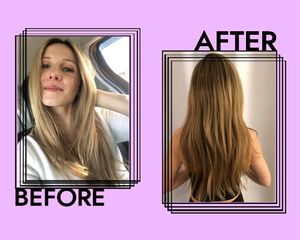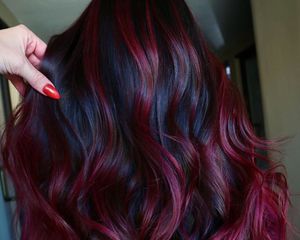:max_bytes(150000):strip_icc()/halolaser1-efdc8edc5b6a47fabe5b81de280968b5.png)
Stocksy
Imagine taking all of your skin concerns—hyperpigmentation, acne scars, dullness, and fine lines, to name a few—and resurfacing them away to reveal a new layer of glowy, healthy skin. That's essentially what laser treatments do. One type of popular laser treatment that has a strong reputation, with users touting "Halo glow" results throughout social media, is the Halo Laser.
This skin-brightening, skin-smoothing laser treatment imparts results that last for years, and some fans even say they don't need makeup for quite a while after treatment. However, it can be intimidating to undergo a procedure like this, no matter how big of a result it gives or how little downtime is required. With that in mind, I tapped cosmetic surgeon Claudia J. Kim, DO, as well as board-certified dermatologist Roberta Del Campo, MD, to answer everything you need to know about the Halo Laser, including cost, benefits, and potential side effects. Plus, I had the treatment done myself to gain an inside perspective.
Scroll on to learn more about the Halo Laser and read my honest review.
Meet the Expert
- Claudia J. Kim, DO, is a cosmetic surgeon who is the medical director at New Look New Life Cosmetic Surgical Arts in New York City.
- Roberta Del Campo, MD, is a board-certified dermatologist and is the founder of Del Campo Dermatology and Laser Institute.
What Is the Halo Laser?
The Halo Laser is a hybrid treatment that combines the powers of an ablative laser and a non-ablative laser to resurface the skin. “Think of it as a chemical peel on steroids,” Dr. Kim says. “The ablative laser evaporates or pulverizes the top layers of skin to address more superficial areas, while the non-ablative laser creates controlled, deeper micro-traumas in the subcutaneous layers of skin to simulate inflammation and promote both skin-tightening and collagen production.” While the term “micro-trauma” sounds like something you wouldn’t want, Dr. Kim notes that it’s actually a good thing—by tricking the skin into thinking it’s injured, it causes your natural healing process to go into overdrive, creating more collagen and in turn, addressing skin texture issues like oversized pores, fine lines, wrinkles, roughness, laxity, and acne scars.
Benefits of a Halo Laser Treatment
For those who have several different concerns with skin texture, tone, and damage, the Halo Laser may be worth considering due to its multiple potential benefits. A few main things the treatment may help with are as follows:
- Stimulates collagen and promotes tighter skin
- Removes hyperpigmentation and sun damage
- Smooths over uneven texture
- Diminishes fine lines and wrinkles
- Reduces the appearance of pores
If you want to completely resurface uneven skin texture and impart a more even tone in a single session, then the Halo laser is a good option for you. “The combination of the ablative and non-ablative lasers allows you to combine the high strength of the ablative with the collagen-stimulating powers of the non-ablative, resurfacing your skin to reveal the healthier complexion underneath,” explains Dr. Kim. “This would be the ideal treatment for someone who isn’t new to laser treatments and wants a more dramatic result.”
By obliterating the first few superficial layers of skin, the newer, healthier skin underneath is able to surface, and the increase in collagen promotes a smoother, more even finish. Because we’re exposed to the elements and sun damage can always happen to even the most diligent of us, Dr. Kim notes that, after your initial treatment, you’ll only need to follow up with annual Halo sessions to reverse any environmental impact from the previous year.
How to Prepare for a Halo Laser Treatment
The first thing you'll want to do before your Halo Laser treatment is stop using any retinoids in your existing lineup. “Topical retinoids can make your skin more sensitive to the laser, so avoid them in the two weeks leading up to your treatment,” Dr. Kim explains. Stick to a pretty simple skincare routine and use light, mild formulas that keep your skin hydrated—Dr. Kim recommends the Cetaphil cleanser, moisturizers by either Cetaphil or CeraVe and your usual daily sunscreen. “While sunscreen is important to use year-round, it’s especially important before your Halo treatment,” she says. “Because you’re resurfacing your skin, you don’t want sun damage to cause any hyperpigmentation regardless of the upcoming laser treatment.”
And speaking of hyperpigmentation, certain skin types might need to incorporate hydroquinone each night starting two weeks before the Halo treatment. “If you have more melanin in your skin, inflammatory processes can cause hyperpigmentation, which is called PIH—post-inflammatory hyperpigmentation,” Dr. Kim says. “Usually, when patients experience that, we prescribe the hydroquinone to pre-treat the skin for any inflammation to avoid any potential PIH post-treatment.”
You’ll also want to prepare for the downtime associated with the Halo Laser mentally. “The healing process will look scarier than it actually feels, and in the days that follow, you’ll start to get the epidermal debris, also known as MENDS—or microscopic epidermal necrotic debris,” Dr. Kim explains. “They’ll show up in the form of little brown spots all over your face, which peel off as the Halo result starts to surface.” The MENDS can take anywhere from five to seven days to completely fall off, and Dr. Kim notes that slight swelling for one to three days following the treatment isn’t uncommon.
Dr. Del Campo adds that often, "The downtime is based on which settings are used. Non-ablative settings will entail approximately a week of minimal downtime, whereas an aggressive ablative treatment will result in closer to moderate downtime lasting 10-14 days."
What to Expect During the Halo Laser Treatment
Depending on whether or not your skin is breakout-prone, your provider may choose to pre-treat your complexion with a device to target acne. This was the case for me, and my practitioner Rita used the Forever Clear BBL laser on my skin to zap any lingering breakouts below the skin. Then, she gave me two Advils, applied numbing cream, and allowed it to sit for an hour. A word to the wise: The treatment is not one of those chill laser facials you can get on your lunch break and not have anyone notice. Numbing is required, and I imagine the process would be pretty painful without it, since it wasn’t precisely sensation-less even with the numbing cream. Granted, the New Look New Life team prepared me for this—during my consultation with Janette, she expressed how she found the treatment to be pretty painful but completely worth it.
After my practitioner Rita mapped out the quadrants of my face, she went to work with the Halo device, working section by section. It wasn’t the most painful sensation in the world (says the girl who has six tattoos so far), though I’d equate it to a combination of intense heat and the dull snap of a rubber band. The areas around my hairline, near my brows, and on my upper lip were the most sensitive, and once my full face had been completed, Rita applied a topical steroid to cool down the skin and soothe inflammation. “The steroids also help to calm down the skin so that the inflammation doesn’t cause hyperpigmentation,” Dr. Kim adds.
Aftercare
After your Halo Laser treatment, you’ll be instructed to wash your face three to four times a day using lukewarm water with a mild cleanser like Cetaphil. Moisturize frequently and us a mineral-based sunscreen with SPF 30 or more, even if your exposure to the outdoors is limited to the window in your apartment. When you shower, keep the temperature on the cooler side, and make sure you don’t stick your face directly under the stream of water to avoid triggering any PIH.
As you continue to wash your face, the MENDS will naturally come off as the skin heals, so resist the urge to pick or peel at them prematurely. This can be hard as the tight and dry feeling starts to settle in. “Be conscious of how forcefully you’re washing your face so that you don’t take any of the MENDS off prematurely,” Dr. Kim says. “Try to just dab your face with a clean towel or paper towel when you wash it, and try to be as gentle as possible.” She notes that, in most cases, the dermal debris will have peeled off by day seven or eight at the latest and that you should wait two weeks post-treatment to start using any topical retinoids again.
My Experience
As an early-30s beauty enthusiast, I had a laundry list of skin concerns. Those included the aftereffects of tanning bed usage in my teens and pimple-picking; the evidence lingered on my face in the form of hyperpigmentation, red patches, and enlarged pores I had to monitor for budding breakouts and blackheads alike. My skin goal was eventually to become one of those lucky people who wore makeup as an extracurricular, and the Halo Laser seemed like the most promising option for getting me there at the speed of light.
Before my Halo laser treatment, my skin was more or less as temperamental as it was when I was a teenager—my pores were definitely visible. The signs of past breakouts linger in the form of hyperpigmentation and some red, sensitive areas.
:max_bytes(150000):strip_icc()/halolasertreatmenthealingprocess-8c65db693eec4580aeeed8bf907d5653.jpg)
Marianne Mychaskiw/Design by Cristina Cianci
Immediately after, my skin was extremely red and sore, and the dermal debris began showing up within the first two days following the treatment, with the MENDS being the most dramatic on day two (pictured above). By day three, the epidermal debris started to fall off more and more as I continued to wash my face, and by day four, I was starting to see more of that “Halo glow” peeking through, albeit with a bit of redness. While the epidermal debris continued to fall off on days five (also pictured above) and six, my skin had calmed down significantly, and a full week after the treatment, that coveted “Halo glow” was in full force.
The Halo Laser is one of the best things to happen to my skin in recent history. My pores are less noticeable, my skin became more even in terms of tone and texture, and I got this otherworldly glow. I wasn’t the only one who noticed—friends, family, and even my husband (who didn’t even notice when I once came home bruised after a filler appointment) commented on how great my skin looked and asked what I was using as if I was an influencer with a huge following. Among all the things I could have listed on my bingo card, I never would have thought that having really, really, ridiculously good skin would be an option. I fully plan to get my yearly Halo touch-up come next year—I’ll just leave my camera off for the Zoom meetings in the few days that follow.
Potential Side Effects
Immediately after treatment, you may experience a mild sunburn-like sensation that fades within a few hours. Minor redness, swelling, discomfort, and skin peeling in the treated area are also possibilities, lasting from a couple of days up to a month or two after treatment, depending on the strength of the settings used. As with any laser treatment, the Halo Laser also carries burning, blistering, scarring, and infection risks. That's why Dr. Del Campo stresses, "It is important to seek an experienced provider as scarring or permanent abnormal pigmentation can occur."
After initial side effects, the main potential risk is developing PIH—which, as we noted before, stands for post-inflammatory hyperpigmentation. If it takes shape, Dr. Kim notes that it can easily be treated with either a prescription-grade retinoid or hydroquinone.
Pain Level
While pain varies from person to person, the Halo Laser treatment is generally well-tolerated. Some say the treatment is virtually painless, while others describe it as being a little uncomfortable, with the intensity increasing as the treatment progresses. "When a topical anesthetic is used, the discomfort should be minimal," Dr. Del Campo says.
How Long Do the Effects of Halo Laser Last?
Results from a Halo Laser treatment typically last one to two years. However, factors like aging, sun exposure, and lifestyle choices can affect the duration. That's why Dr. Del Campo often recommends "maintenance treatments as needed" after the first treatment "to maintain collagen production and keep the skin quality healthy."
The Halo Laser vs. the Clear + Brilliant Laser
Because of its ability to also treat fine lines, pores, uneven texture, and hyperpigmentation, the Clear + Brilliant Laser is often compared to the Halo Laser. On paper, the two seem incredibly similar—with Clear + Brilliant’s claims of no downtime being a plus—but according to Dr. Kim, it would take multiple rounds with the Clear + Brilliant laser to achieve a result similar to that of a single session with the Halo Laser. “Clear + Brilliant is a great modality, but it’s less intense, so you’d have to do it more frequently to get similar results as Halo,” she says.
Clear + Brilliant, however, would be a good entry-level treatment for someone with little experience in the laser realm who would eventually like to try the Halo method—baby steps.
The Cost
The Halo Laser treatment has an average cost of $1500, but the final price may be slightly higher or lower depending on your practitioner and whether or not any pre-Halo treatments are needed. For example, the pre-treatment session with the Forever Clear BBL laser used to target acne on my skin would have been an additional cost to the overall sticker price.
The Final Takeaway
The Halo Laser is a hybrid ablative laser and non-ablative laser that resurfaces skin to remove dead skin. In revealing a new layer of skin, this procedure can diminish the appearance of fine lines, sun damage, hyperpigmentation, acne scars, and pores for up to two years. When done by a certified professional, side effects and downtime are minimal, with redness, swelling, and peeling occurring anywhere from a few days to a month after treatment. On average, the Halo Laser costs $1500, but the final price may be slightly higher or lower depending on your practitioner and whether or not any pre-Halo treatments are needed. If you have any questions regarding candidacy, cost, pain levels, or what to expect during your specific treatment, speak with your provider before going under the laser.











